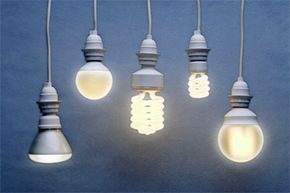Incandescence: Creating Light With Heat
Probably the most common way to energize atoms is with heat, and this is the basis of incandescence. If you heat up a horseshoe with a blowtorch, it will eventually get red-hot, and if you indulge your inner pyromaniac and heat it even more, it gets white hot. Red is the lowest-energy visible light, so in a red-hot object the atoms are just getting enough energy to begin emitting light that we can see. Once you apply enough heat to cause white light, you are energizing so many different electrons in so many different ways that all of the colors are being generated -- they all mix together to look white.
Heat is the most common way we see light being generated -- a normal 75-watt incandescent bulb is generating light by using electricity to create heat. Electricity runs through a tungsten filament housed inside a glass sphere. Because the filament is so thin, it offers a good bit of resistance to the electricity, and this resistance turns electrical energy into heat. The heat is enough to make the filament glow white-hot. Unfortunately, this isn't very efficient. Most of the energy that goes into an incandescent bulb is lost as heat. In fact, a typical light bulb produces perhaps 15 lumens per watt of input power compared to a fluorescent bulb, which produces between 50 and 100 lumens per watt.
Advertisement
Combustion offers another way to produce photons. Combustion occurs when a substance -- the fuel -- combines rapidly with oxygen, producing heat and light. If you study a campfire or even a candle flame carefully, you will notice a small colorless gap between the wood or the wick and the flames. In this gap, gases are rising and getting heated. When they finally get hot enough, the gases combine with oxygen and are able to emit light. The flame, then, is nothing more than a mixture of reacting gases emitting visible, infrared and some ultraviolet light.
Next up we'll shine a light on lasers.
